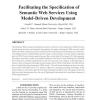Free Online Productivity Tools
i2Speak
i2Symbol
i2OCR
iTex2Img
iWeb2Print
iWeb2Shot
i2Type
iPdf2Split
iPdf2Merge
i2Bopomofo
i2Arabic
i2Style
i2Image
i2PDF
iLatex2Rtf
Sci2ools
JWSR
2006
2006
Facilitating the Specification of Semantic Web Services Using Model-Driven Development
The Semantic Web promises automated invocation, discovery, and composition of Web services by enhancing services with semantic descriptions. An upper ontology for Web services called OWL-S has been created to provide a mechanism for describing service semantics in a standard, well-defined manner. Unfortunately, the learning curve for semantic-rich description languages such as OWL-S can be steep, especially given the current state of tool support for the language. This paper describes a suite of automated software tools that we have developed to facilitate the construction of OWL-S specifications. The tools operate in two stages. In the first stage, a model-driven architecture technique is used to generate an OWL-S description of a Web service from a Unified Modeling Language (UML) model. This allows the developer to focus on creating a model of the Web service in a standard UML tool, leveraging existing knowledge. In the second stage, an interactive approach for generating groundings...
JWSR 2006 | Semantics | Tools | Web Service |
Related Content
| Added | 13 Dec 2010 |
| Updated | 13 Dec 2010 |
| Type | Journal |
| Year | 2006 |
| Where | JWSR |
| Authors | Gerald C. Gannod, John T. E. Timm, Raynette J. Brodie |
Comments (0)

